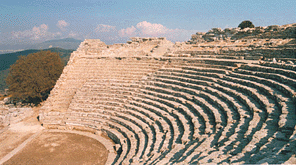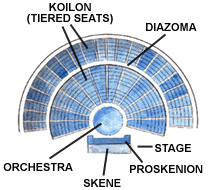...Best of Sicily presents... Best of Sicily Magazine. ... Dedicated to Sicilian art, culture, history, people, places and all things Sicilian. |
by Carlo Trabia | ||
Magazine Index Best of Sicily Arts & Culture Fashion Food & Wine History & Society About Us Travel Faqs Contact Map of Sicily |
Why does a spectator sitting in the part of a Greek amphitheatre farthest from the stage hear an actor on-stage almost as loudly and clearly as a spectator in the front row? Recently (January 2007), two American scientists studying the field of acoustics reported an interesting discovery about how and why sound travels so well in Greek amphitheatres such as those at Segesta (shown here), Taormina and a number of sites around Sicily. Their study incidentally helps to further explain why the acoustics in these semi-circular amphitheatres is superior to what one experiences in the oval-shaped Roman theatres and circuses (more about that later). Marcus Vitruvius Pollio (born circa 80 BC), an architect of ancient Rome best known as designer of the Vitruvian water-screw, theorized that it was the gentle slope of the Greek amphitheatres which favored sound as it rose. He was mistaken. It turns out that height has nothing to do with it. Rather, it's a question of the "corrugated" and non-absorbing surface formed by the stone seats altering sound waves in a certain way, filtering out some while accentuating others. Taking as their test model the Greek theatre at Epidaurus (similar to those of Segesta and Taormina but larger), the scientists discovered why the voices of actors on the stage or in the orchestra travel, without the need of any kind of amplification or mechanical noise-reduction, in a crisp, clear manner to spectators seated in the uppermost (i.e. most distant) part of the koilon (tiered "steps") of the theatre. The effects are based on a common principle called acoustic diffraction, though there are actually several forces at work. Simply expressed, in an open amphitheatre, especially one in which at
least half the seats are not occupied, various frequencies of sound diffract
off the ascending "corrugated" surface, and Though an actor on the stage must speak loudly enough to be heard, we are really talking about the frequency of sound. (Let's bear in mind that frequency is not volume. Frequency is the rate per second, measured in hertz, at which sound waves vibrate, while volume is the loudness or intensity of audible sound, measured in decibels. For our purposes, however, it's all a question of what you can hear; certain high-frequency sounds can be heard by animals but not people.) The acoustic diffraction in the amphitheatres does not actually make the voices of the on-stage actors louder, but it does allow the sound of their voices to travel farther while most sounds coming from spectators in the tiered seats do not travel as far. In effect, the higher vocal frequencies remaining (and emanating from the acoustically-favored stage area) are sufficiently preserved to facilitate listeners hearing them more distinctly, while the others (coming from the seats) literally disappear. If speakers having very similar tonal voice quality (such as identical twins) standing in the amphitheatre, one on stage and the other high in the tiers, spoke loudly at the same volume and frequency (vocal pitch and tone) at the same moment, a listener in the tiers on the other side of the theatre (but positioned an equal distance from both twins) would hear the voice of the twin on stage with slightly greater clarity. The voice of the twin on stage would have the advantage of greater acoustic diffraction, while the voice of the twin in the seats would not. The effect would be even more pronounced if the on-stage twin were speaking at a frequency just a bit above a certain level (over 500 hertz) while the twin in the tiers was speaking even slightly below this level. The audible differences in the amphitheatre would be far greater than they would be in a field, cubic room or other environment. But even some of the sound generated by the on-stage speaker is lost, notably in the lower frequency range. This reminds us that the full range of speech is important but it's not always essential. To understand this, let's consider a phenomenon observed daily in telecommunications and even some music recordings (typically those downloaded from the internet). Here the listener's brain "reconstructs" tones in the missing lower frequencies by concentrating on the higher (audible) ones instead of those in the absent lower range. It is also an effective form of noise reduction, if "noise" is defined as distracting or undesired sound. As an aside, it's worth mentioning an obvious problem sometimes encountered in oval Roman theatres, as opposed to the semi-circular Greek amphitheatres: echo. This occurs when sound waves reflect, or "resonate," back and forth off the walls before dissipating. Most opera houses and lecture halls follow the acoustic example of the Greek amphitheatres, while sports stadiums (where audience noise is usually welcome) follow the Roman one. Of course, this all presumes ideal conditions. The perfect acoustics described here might be corrupted considerably in an amphitheatre full of spectators at the crowded performance of an Aeschylus play. The bodies and clothing of the audience would absorb and dissipate the sound waves, which could not skim off the tiered stone seats, so ironically an unpopular play, instead of a full house, might prove to be most worth attending --at least from an acoustic point of view. Nowadays, mechanical amplification (speaker systems) are set up when plays are performed at Segesta and Taormina, so the entire issue has been rendered academic. But to historians it remains a fascinating proof that traditional architectural wisdom is sometimes the most reliable. About the Author: Architect Carlo Trabia has written for this publication and others. | |
Top of Page |
 Every once in a while somebody discovers that ancient wisdom has some
scientific merit. To historians and archeologists it is especially interesting
when the focus of the discovery involves architecture which is still standing after many centuries. For a long time
a series of subtle academic debates has pitted Roman architecture against
what was known and applied by the
Every once in a while somebody discovers that ancient wisdom has some
scientific merit. To historians and archeologists it is especially interesting
when the focus of the discovery involves architecture which is still standing after many centuries. For a long time
a series of subtle academic debates has pitted Roman architecture against
what was known and applied by the  reflect off the walls
surrounding the koilon (see the diagram) and skene (partly
destroyed in some of the Sicilian amphitheatres). But only sound waves at
a certain frequency are backscattered by the seats. The "threshold"
is usually about 500 hertz, meaning that murmurs originating in the seats, and even the sound of
rustling trees nearby or barking dogs in the distance --which might otherwise
have overpowered the actors' voices-- are dissipated.
reflect off the walls
surrounding the koilon (see the diagram) and skene (partly
destroyed in some of the Sicilian amphitheatres). But only sound waves at
a certain frequency are backscattered by the seats. The "threshold"
is usually about 500 hertz, meaning that murmurs originating in the seats, and even the sound of
rustling trees nearby or barking dogs in the distance --which might otherwise
have overpowered the actors' voices-- are dissipated.